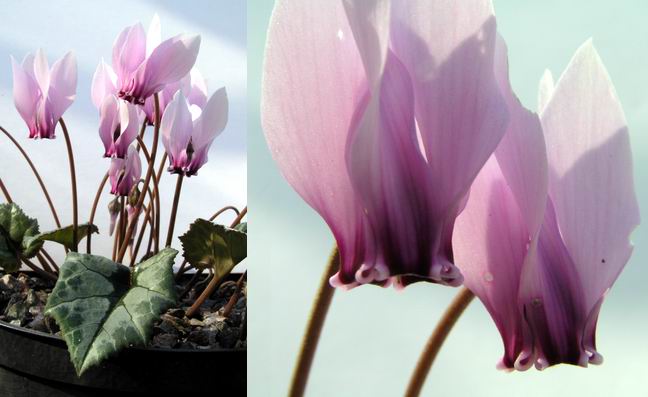|
BULB LOG 39 - 21st Sept. 2004

Leucojum roseum
This tiny Leucojum roseum is still flowering, and, the early stems are topped off with swelling seed capsules - a very welcome sign. Although this is a tiny flower it has a mighty scent, if you have not sampled it, get close and fill your senses.

Cyclamen intaminatum in bed
Another tiny flower and the smallest of the Cyclamen is C. intaminatum (see log 36 for scale). Here it is growing out in one of our raised beds where it can be appreciated and it looks perfectly natural coming out between the rock crevices.

Cyclamen intaminatum
In the bulb house we have several pots of it growing where we can also appreciate the delicate and very beautiful flowers. Some are pinker than others and these are my favourites, especially with the thin grey lines extending up the petals.

Cyclamen africanum
Going up towards the other end of the size scale we find Cyclamen africanum which is the biggest Cyclamen that I know, not counting the florist selections, a plant with fine large flowers and leaves.

Cyclamen in seed
As well as the very obvious Arum seed you can see that the stems of this Cyclamen hederifolium, top right, are coiling down drawing their fertilised seed pod tight to the ground. Cyclamen seed takes longer to ripen than any other bulb that we grow; this will not be ripe until at least July or August next year. As well as the odd weed you will see lots of tiny Cyclamen seedling leaves resulting from previously uncollected seed. It is always a good idea to leave some seed on your plants to self sow; given time this gives one of the best forms of 'natural planting' and brings a mature look to a garden.

Crocus banaticus & fly
Crocus time is here again. This is a plant that most that are not "in the know" only associate with spring, but when you get into bulbs you will find that you can have a crocus in flower from July until May, that is eleven out of twelve months. Crocus banaticus is unique among crocus because the flower segments are not equal in length; the inner three are much shorter than the outer three. While the basic distinctive shape of this crocus remains constant, there are many variations in the depth of colour, from pure white forms through to very dark purple forms, my favourites show good contrast between the 'petals' and style, like the one above.

Banaticus fly
In case you are thinking that I spent ages waiting for the hover-flies to pose for this picture then I must tell you that there are so many hover-flies around just now, when the sun is shining, that I would have to wait a long time to picture a crocus without them. Just enjoy the dark purple complex style, the golden pollen-laden anthers and the fly.

Crocus in bulb house
We also grow most of these crocus in the garden but it is always nice to be able to enjoy them under glass where they are protected from the winds and heavy rain which batter them in the open.

Crocus hadriaticus
The typical white form of Crocus hadriaticus is on the right and a lilac form, C.hadriaticus lilacinus to the left.

Crocus boryi & kotschyanus
On the left is Crocus boryi with the first flowering of this Crocus kotschyanus ssp harkariensis. This is given as a sub-species of C. kotschyanus mainly because its corm lies on its side in the soil. If, like us, you re-pot it every year you may not notice this feature. Because we plant it upright as a normal crocus and it needs to be left alone for a couple of growing seasons for the corm to orientate itself on to its side.

Crocus speciosus x2
Here I show you two forms of the variable Crocus speciosus the typical colour on the left and the white form to the right. The violet/blue form here has a yellow throat which places it in the sub species of Crocus speciosus ssp xantholaimos. Yes, like all bulbs, the taxonomy of Crocus is complex and often confusing but do not let that stop you enjoying these wonderful flowers.
We do not need to know the precise name of the flower in front of us to enjoy its beauty and the pleasure it gives us - and the scent. Get into the habit of always smelling a flower; I think that this is a much undervalued taxonomic diagnostic indicator especially as it is one of the main attractions to pollinators one of the driving forces of plant evolution.
I will leave you with this picture of Crocus speciosus ssp. xantholaimos it has a wonderful scent, I wish you could smell it.

Crocuc speciosus xantholaimos
^ back to the top ^
|

